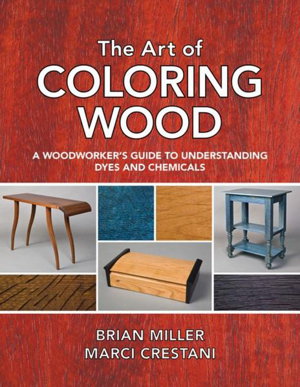
PublishedLinden Publishing Co, November 2017 |
ISBN9781610353052 |
FormatSoftcover, 128 pages |
Dimensions27.9cm × 21.6cm |
Brian Miller's new The Art of Coloring Wood will take your woodworking to a new level by taking the mystery and intimidation out of finishing with chemicals and dyes. You'll never use a basic stain on your handcrafted masterpiece ever again. If you're a woodworker looking to take your skills and your next project to a higher level of craftsmanship, you might want to consider colouring your wood with chemicals and dyes instead of stains.
Unlike stains that can trap light and obscure grain patterns, chemicals and dyes, when handled properly, are one of the best methods for enhancing a wood's colour or accentuating the grain pattern. A classic technique that's been practiced for centuries, colouring wood is a sure way to infuse a "wow" into your woodworking efforts. With expert guidance by Brian Miller, a professor of Wood Technology who teaches an actual course on colouring wood, The Art of Coloring Wood removes any and all intimidation of working with chemicals and dyes and is the perfect entry point for anyone looking to move on from simple stains to learn the art of coloring wood for dramatic effect. To keep the information accessible and relevant, The Art of Coloring Wood focuses on the six most popular woods used by woodworkers maple, quartersawn white oak, mahogany, walnut, cherry and alder and outlines the unique characteristics with regard to coloring each. After the six woods are outlined, The Art of Coloring Wood moves onto the supplies needed, including brushes, sandpaper, and much more, before proceeding into the easy-to-follow and engaging chapters on the different chemicals and dyes that will make your woodworking shine. The beauty of The Art of Coloring is Miller's simple approach that makes the chemistry very easy to understand. Each chapter offers recipes, insights, and many "a-ha!" moments that make learning about chemicals and dyes both fascinating and within easy reach. With the helpful sidebars throughout the book offering tips, mistakes, and countless nuggets of information, The Art of Coloring Wood will have you understanding the methods and many worthwhile reasons for colouring your wood while chomping at the bit to get a project completed so you can finish it with style and flair. SELLING POINTS: . Separates out and breaks down what appears to be intimidating staining with chemicals and dyes into an easy-to-understand and very simple process that provides dramatic results. . The book is based on an actual class taught by the author, an woodfinishing expert and acting faculty member in Wood Technology. Every woodworker needs to finish a project and this book will attract a very large audience seeking accessible information for this classic and undercovered method. . The woodworking community is replete with with engineers, doctors, and other STEM-based professions, making chemistry a popular element in the craft. . Audience Woodworkers of all skill levels Artists working with wood. Woodworking teachers and instructors Builders, architects, and interior designers

